Bugs rely on antennae for many vital functions such as orientations. Some bugs rely on antennae so much that they might even be longer than the bug itself.
Long antennae can have one or multiple purposes in bugs. It can help them stay away from potentially-dangerous situations or help them find the type of food they’re interested in consuming.
Long antennae also help some migratory bugs make their way through long distances without ending up in a different destination.
Studies show long antennae also help these migratory bugs balance their movements or flights to use as little energy as possible when moving around.
Table of Contents
What Are Bug Antennae?
Antennae are known as elongated sense orangs, typically located on the head. The elongated shape is characteristic of all antennae even if they can look different from one species to another.
Primary and secondary antennae are sometimes distinguished in some bug species. You can see primary antennae as the longest in most cases.
Regardless of their length, bug antennae have 3 main parts.
Scape (anchor) – this segment is located on the head. It helps with antennae movements.
Pedicel (base) – the immediate short segment between the scape and flagellum.
Flagellum (the elongated part) – is the longest and most visible part of the antennae. A section with receptors
All of these parts of the antennae help bugs in multiple ways from movement to feeding.
Antennae Function
Here’s how antennae help bugs in daily tasks.
Olfactory receptors
One of the first functions of bug antennae is with olfactory receptors. Antennae have multiple receptors within them that aid with the smell.
Bugs rely on smell for food. Those that eat pollen need to smell certain types of plants to reach them. Predatory bugs can use olfactory receptors to reach areas where they can find insects.
Olfactory receptors are also essential for migrating bugs or bugs moving locations. Overcrowding of an area is one of the reasons bugs might look for other areas to live in.
Bugs that are pests rely on olfactory receptors to find organic waste, decaying foods, or fresh foods around the house.
Orientation
Bug antennae help with orientation to a high extent. Long and short antennae are useful for bugs to move.
Some bugs have good vision and rely less on antennae for movement. Other bugs don’t have good vision and are almost dependent on antennae for movements and to avoid collisions.
Cockroaches are among the species that heavily rely on antennae to avoid colliding with objects. They also use antennae to locate walls. Moving along walls helps cockroaches be less exposed to potential predators.
Courtship
Mating and courtship are rituals of bugs that sometimes depend on antennae.
Both males and females rely on the receptors in antennae to signal mating availability. Picking up mating-specific odors is mostly possible through neuro-receptors in antennae.
Laying eggs
Female bugs sometimes rely on antennae on finding a suitable spot to lay eggs in. This involves looking for a safe place or a host plant.
Female butterflies look for specific host plants to lay eggs on using their antennae. Only specific plants can later be used as food by their caterpillars.
Detecting temperature changes
Temperature changes and seasonal changes are sometimes distinguished by bugs with antennae. They know when the weather gets cold and when to seek shelter.
Bugs also rely on antennae to distinguish humidity levels. Silverfish and some cockroaches are known to prefer high-humidity locations.
Temperature changes assessed by antennae help many bugs move indoors whenever the weather goes bad.
Cockroaches use antennae to determine the location of warm humid spots, which sometimes makes them move indoors.
8 Bugs with Long Antennae
The following species of bugs are all known for having visibly long antennae. Some have antennae that are longer than the average while others have antennas longer than their bodies.
1. Longhorn Beetles
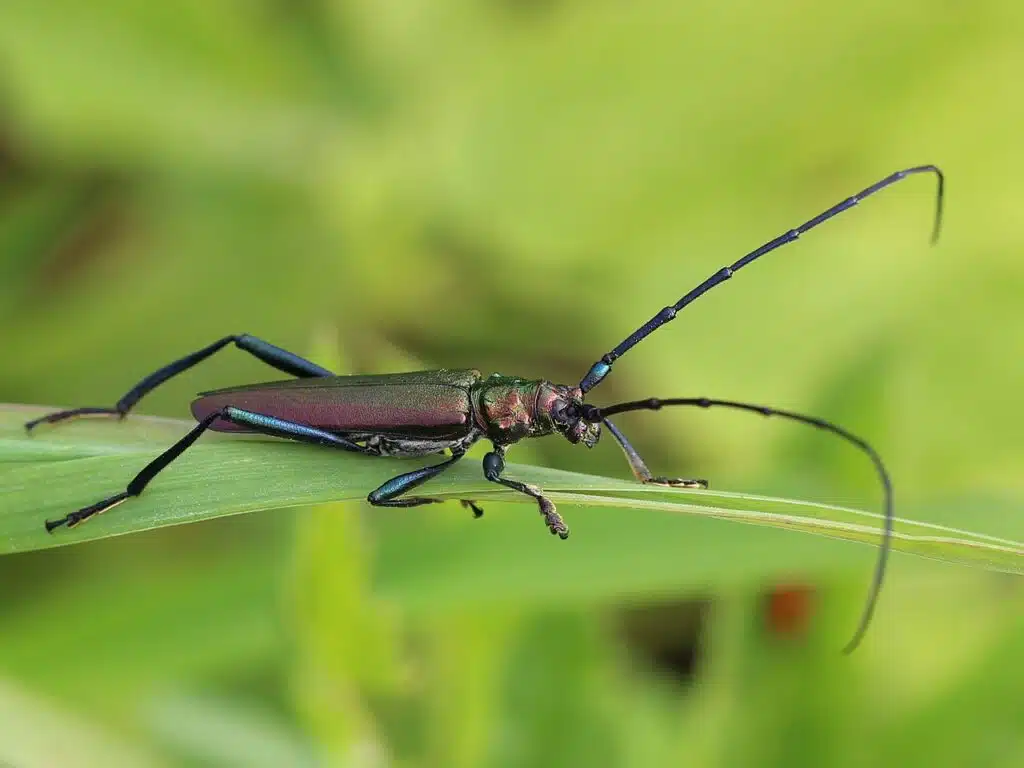
Longhorn Beetles are seen across North America feeding on plants. They eat plant stems and roots.
Some of these beetles even bore into wood.
Almost all Longhorn Beetles have prominent antennae. Some have very long antennae that are even longer than their body.
Titan Beetles have distinguishable antennae pointing outwards.
Decora Longicorn Beetles are the species with some of the longest antennae among all Longhorn beetles. These beetles have antennae 3 times longer than their body.
The segmented antennae of these beetles match the dark red color of the body and are pointing either outwards or backward.
A typical Decora Longicorn Beetle measures around 18mm. Their antennae measure anywhere between 2 and 3 times their body length.
The antennae of this species can be as long as 54mm.
2. Caddisflies
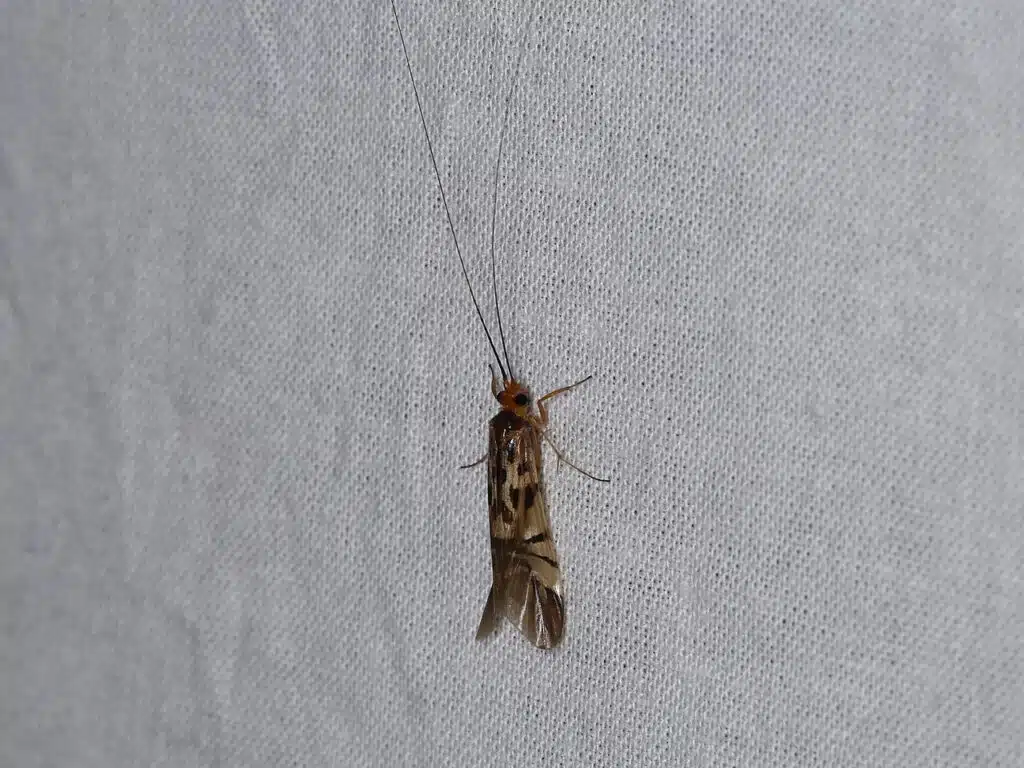
Caddisflies are some of the most common long antennae flies next to water sources. This is why they are mimicked in artificial bait in fly fishing.
These types of flies live in warm climates around the world.
They lay eggs in lakes, ponds, rivers, and streams among other permanent water sources.
Caddisflies have large hairy wings with very long antennae. The antennae of these flies normally match the coloring of the wings.
There are more than 14.000 species of caddisflies and most have thin thread-like antennae pointing forward.
Most of these insects aren’t seen in urban areas as they only live close to the water and because they don’t need to fly for food as caddisflies don’t feed.
Much of the lives of caddisflies are marked by efforts of finding suitable places to lay eggs.
Their eggs are laid directly in water, preferably shallow warmer waters.
Sand can be used to cover up these eggs in a protective effort.
The color of the emerging larvae is not tied to the color of the adult. For example, the larvae of the Land Caddis are white while the adult has a dark brown body and dark brown antennae.
3. Crickets
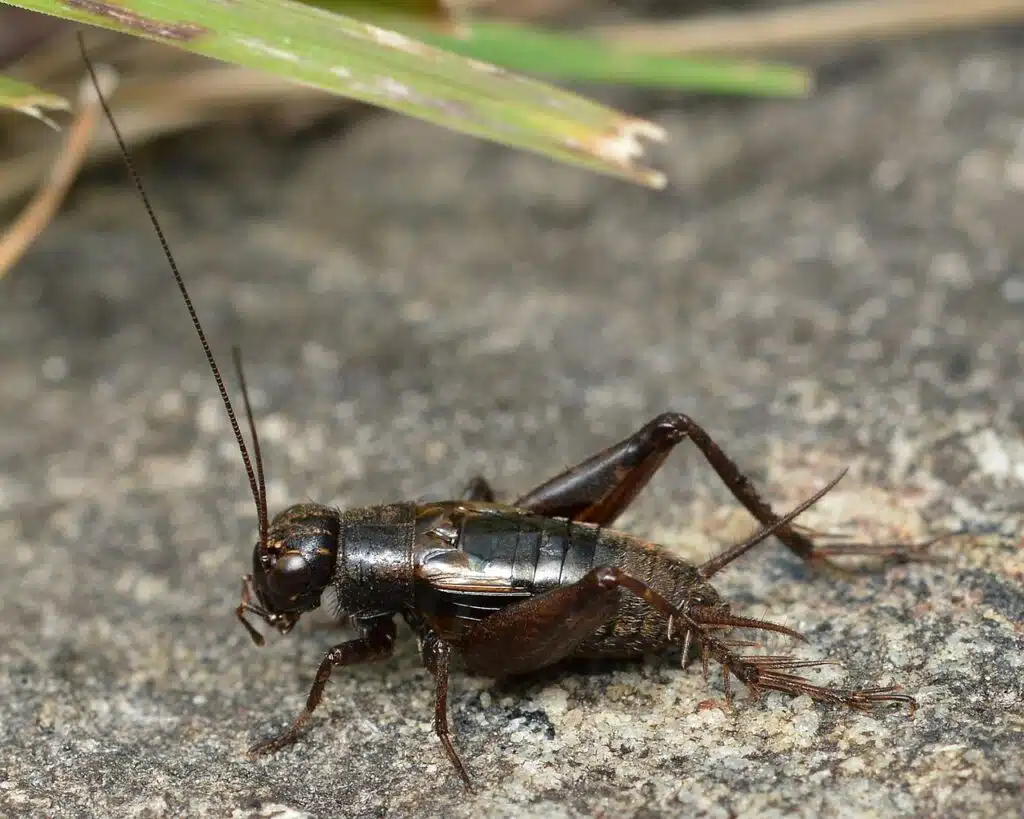
Crickets are some of the most common bugs that have thin smooth long antennae.
Multiple species of crickets live around the world. House crickets are among the most common types of crickets you are likely to see.
Unlike most other black crickets, house crickets have a tan or light brown color.
These types of crickets also have very long thread-like antennae that are longer than the body of the species.
You can see these crickets around the home in the evening when they come out attracted to light.
The antennae of cricket can easily be seen at night when these bugs rest on walls and other vertical surfaces.
With the capacity to climb walls, crickets rely on antennae for detecting changes in surface patterns.
They also rely on antennae to detect temperature and move indoors when the weather gets cold.
4. Cave Crickets
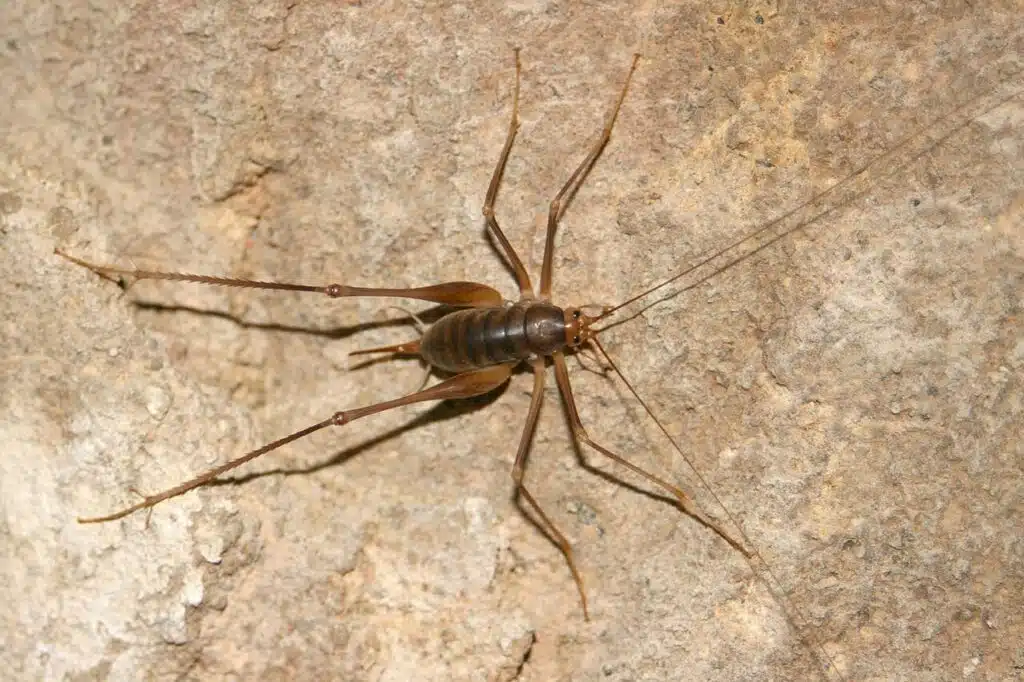
Cave Crickets are some of the most common species in caves and damp places across Australia.
While most of these crickets live in caves, they can also be a common sight in basements, garages, and other damp places such as old mines and tunnels.
The species is primarily known for its extra-long hind legs. It also has extra-long antennae to match its hind legs.
These crickets have now wings and they grow to a maximum length of 2 inches.
Their antennae also measure at least 2 inches.
A few different species of Cave Crickets are also known for having even longer antennae.
While these crickets mostly live in caves, they can occasionally be seen in Australian and Tasmanian homes.
They enter homes via plumbing or cracks in basements where they can remain for a long time.
They create no direct damage to homes which means they cannot be considered true pests.
5. Katydids
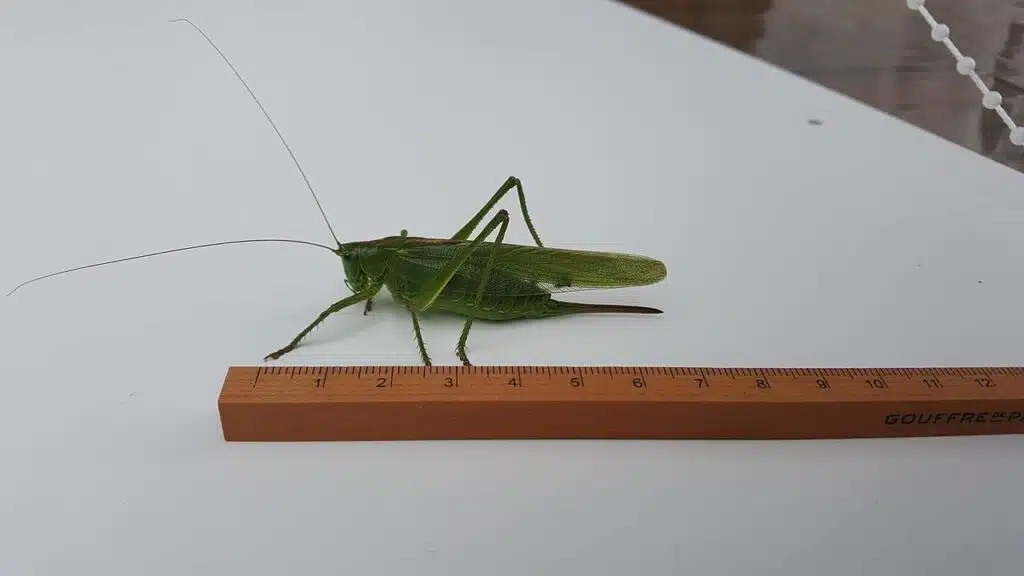
Katydids are some of the largest bugs present in tropical and sub-tropical climates.
While some katydids also live in temperate climates around the world, most live in tropical areas.
Most Katydids are native to Brazil. However, there are hundreds of species present outside of the country.
All katydids have a narrow elongated body with long antennae.
These are plant-eating bugs that eat leaves, flowers, and even plant seeds.
The length of their antennae is considerable.
There are thousands of katydids species with thread-like antennae colored in the same color as the rest of the body.
Saddle-backed Bush Crickets are a light green species of katydids with light green antennae.
Roesel’s Bush Cricket is a similarly-sized katydid with long red antennae.
The group of Australia-native Paraphisis katydids is known for mimicking leaves. They have green coloring, long green antennae, and long green legs which mimic the green veins of leaves.
6. Silverfish
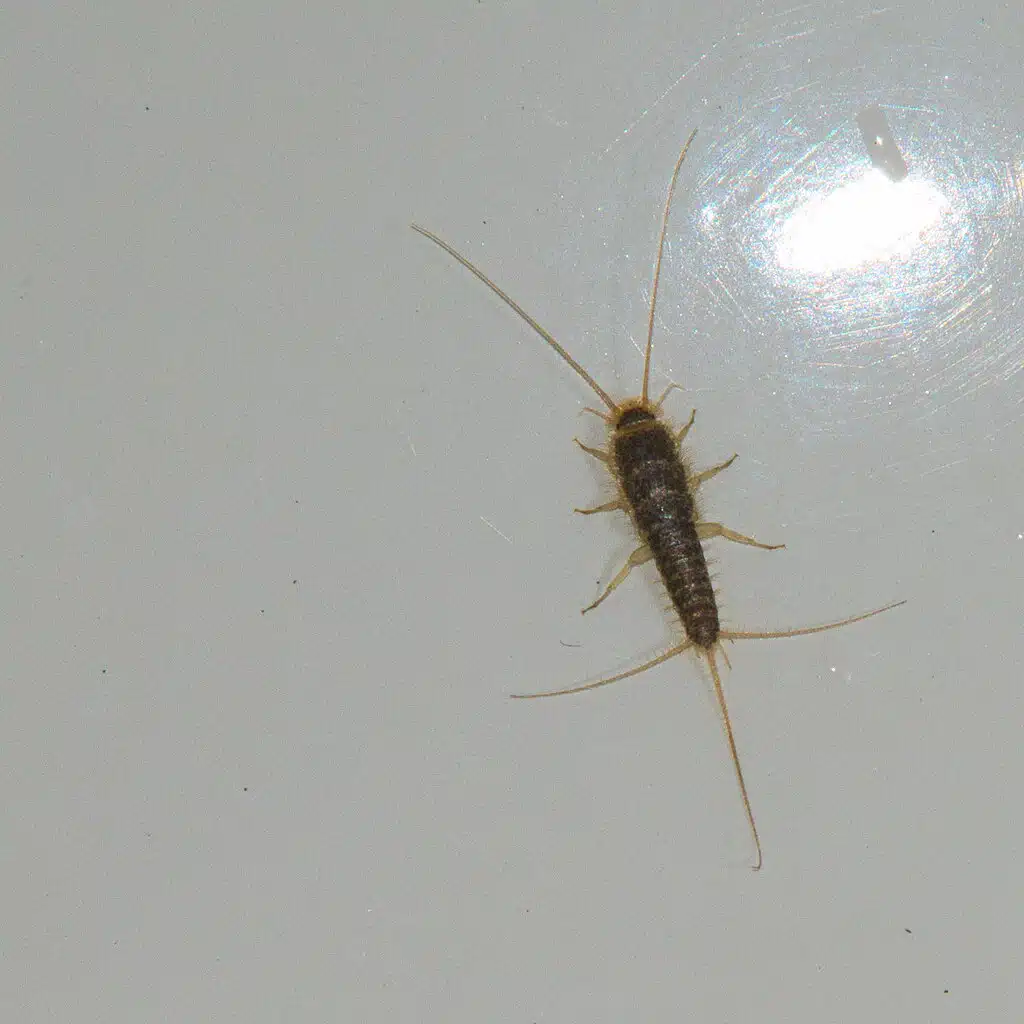
Silverfish are some of the most common bugs with long antennae found inside homes.
These elongated bugs which grow to a size of up to 19mm have antennae longer than the body.
You can find silverfish in the bathroom, under the sink, under the bathtub, or in other cool damp places such as basements.
Silverfish do not bite people but they carry allergens that can trigger allergic reactions.
While silverfish aren’t direct disease-spreaders, they should still be eliminated from homes as they can attract other predatory bugs.
You can eliminate silverfish by using all types of bait.
More natural solutions are also proven to work against silverfish.
These include using essential oils such as cedar essential oil in key areas of the house where most silverfish live, such as the bathroom.
7. Lacewings
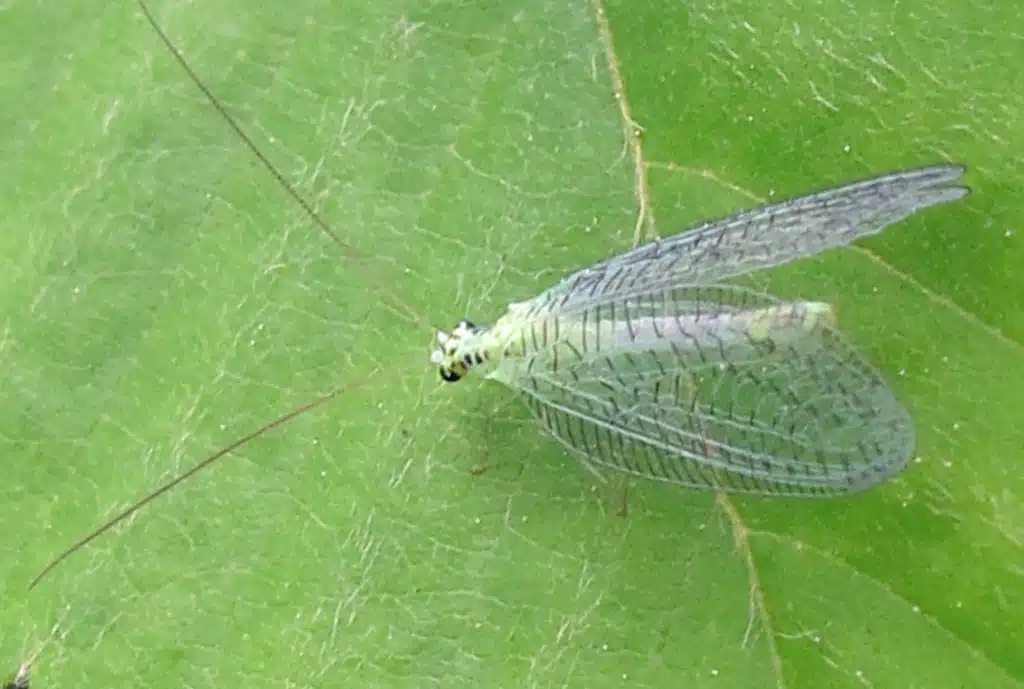
Lacewings are some of the most common insects with long antennae and transparent wings.
Multiple types of lacewings live around the world. All of them have antennae as long as their wingspan can measure up to 65mm.
There are fewer receptors in the antennae of lacewings than in the antennae of other insects.
Lacewings can hear distinguish all types of sounds through tympanal orangs. These organs aren’t located in the antennae but in the body next to the wings.
These insects are also known for having compound eyes. These are very large eyes compared to the size of the head and of the body within the species.
Lacewings are nocturnal insects that are rarely seen flying out in the open during the day.
With plenty of natural predators, these insects come out to eat at night.
The diet of lacewings is diverse and it involves many types of insects found on crops and in the garden.
Lacewings eat detrimental insects such as aphids and honeydew produced by aphids, similarly to ants.
They also eat various plant-eating mites.
Lacewings are also known for eating nectar and pollen as omnivores.
8. Cockroaches
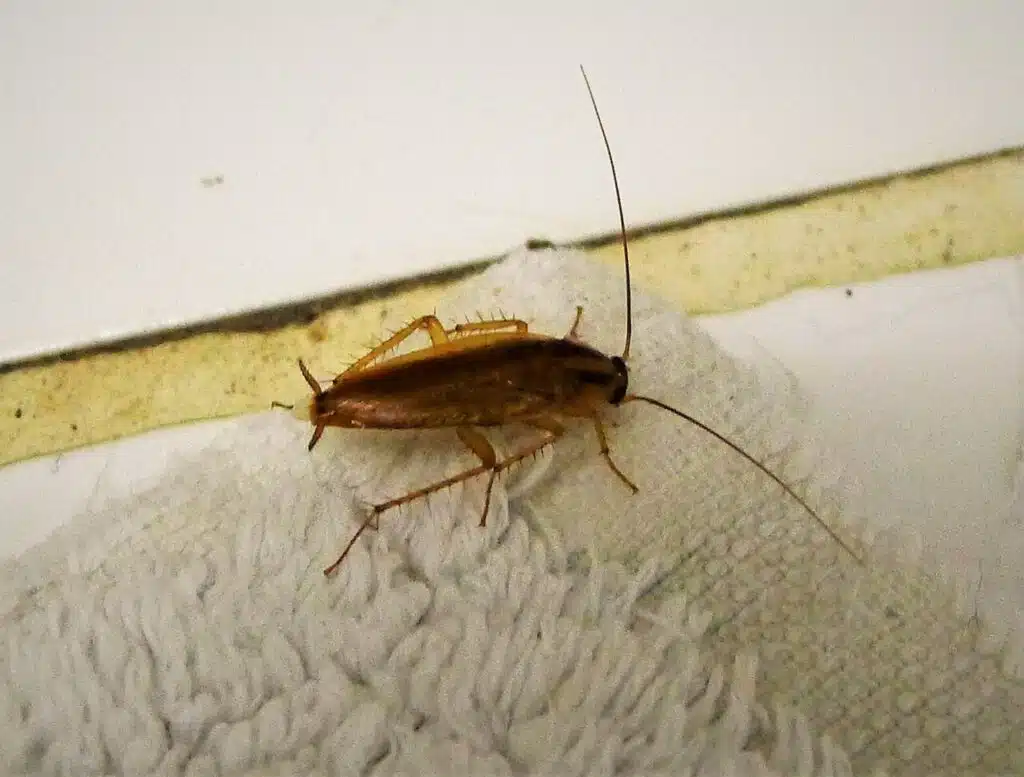
Cockroaches are some of the most common bugs with long and very long antennae. American cockroaches and Oriental cockroaches are both common house pests with long antennae.
These cockroaches rely on antennae for moving around and picking up various odors.
They walk with antennae pointing forwards which is believed to be a tactile sense which stops them from bumping into objects and determining changes in floor or soil surfaces.
Cockroaches also use antennae to move along walls as they prefer to have at least one safe side when moving around the house as cockroaches scare easily.
Cockroaches can also use antennae to determine which cracks in walls have openings on the other side, mainly by assessing draft or temperature changes.
The antennae of cockroaches also allow them to quickly pick up high-humidity areas in the house.
Damp places and areas with water leaks such as those under sinks are often quickly spotted by cockroaches through their versatile antennae.
Summary
Bugs that have long antennae use them for various tasks such as finding food, shelter, or a prospective mate.
These long antennae seem difficult to move around with but many bugs such as cockroaches rely on the perceptions of the antennae to move safely across all habitats.
Long antennae can sometimes be longer than the bug itself. Some of the longest antennae in the bug world measure up to 3 times the length of the body. Longhorn beetles are the bugs with some of the longest antennae in the bug world. Other more common bugs with extensive antennae include common cockroaches.